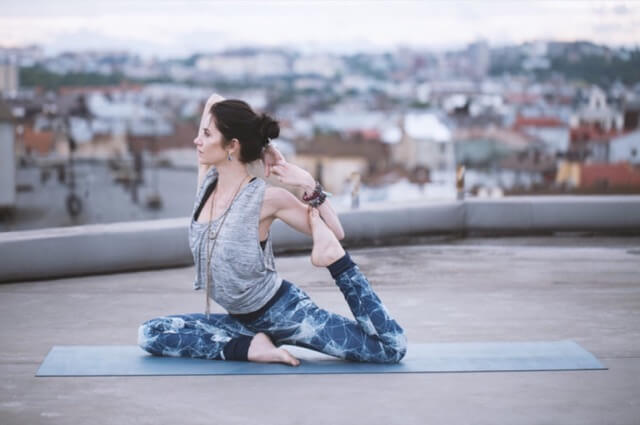Author: Randeep Singh / go to all articles on Yoga cure
Yoga as Jawline Exercises:
Jawline or the mandible is the only bone comprising the skull which is not fused to other bones. The lower jaw is crucial to chewing, speaking, and gesticulating.
It extends from the left to the right temporal bone in the skull, and provides base to 16 teeth which remain partially inserted into it externally, its shape affects the look of the face, and jawline exercises are especially designed to enhance the same.
The jaw bone is attached to the skull with two attaching points called the rami, singular ramus located on end of its slightly curved main body. Osteoporosis or the loss of bone mass is directly linked to a weak alveolar process ( part of the jaw bone which holds the teeth) which leads to tooth loss. Stress related teeth grinding also causes teeth loss.
Loss of teeth has direct impact on the digestion process, mastication (chewing) of food by the teeth with saliva mixed with it is the first step to digestion which begins in the mouth. Teeth help grind the larger, harder chunks of the food into smaller pieces for the enzymes and the acids in the stomach to work upon. People who do not chew well before they swallow the food develop digestion, and absorption of nutrients from there off disorders and issues.
Apart from influencing the general health of the being the shape and tone of the jawline has aesthetic angle to it, The way one looks has an important role to play in the way one feels about oneself in general, it also impacts development and maintenance of interpersonal relationships to certain extent.
The jaws are present a bit behind their normal placing in the temporal mandibular disorder, this can block the air passages situated behind the jaws affecting the quality of respiration. Trigeminal nerve – along with its ancillary nerves – all present in the region of face – provide more than 60 percent of the nerve signals to the brain.
This facial nerve complex communicates directly with the brain and not via spinal cord, the facial nerves if remain tense due to the wrong placement of the lower jaw bone can add tremendously to the overall stress to the brain. Disorders of the jaw line can keep the muscles in the neck tight which can impact the flow of blood within the blood vessels passing through this region.
The movement of the lower jaw ( only the lower jaw can move, the upper jaw is fixed), is linked to the detoxification of the brain which suffers in case of any deformity of functional aberration in the jawline.
Proper working of the lower jaws is important to the release of the digestive juices from the gall bladder, the temporal muscles are directly linked to the gall bladder meridian which passes through the sides of the head. The gall bladder receives the signal of the incoming food through the gall bladder meridian which get stimulated with the movements made by the lower jaw as it masticates, thence it prepares to release the associated digestive juices.
Thus an impaired jaw bone can directly impair the digestion of the ingested food. Modern man has a underdeveloped jaw bone because the changes in the consistency, and texture of his diet (has become more smooth and easy to swallow) has reduced the need to exercise the jaws any more. Thus in order to maintain the health of jawline one needs to exercise it regularly, and yoga for a prominent jawline is the best means to achieve that.

A Strong Jaw Line with Yoga
A lot pf people have the habit of holding their nervous tension in their jaws. Jaws generally hold a lot of subconscious tension present in the body. Headaches, and jaw aches can be caused by the misalignment in the teeth, jaws, or stiffness in the muscles surrounding the jaws.
Face yoga, and the face slimming exercises which form a part of it works a long way to help tone the facial muscles along with helping align the jaws. Lion Pose benefits by stretching the muscles located in the sides of the head and the joint where the jaws attach with the skull.
One of the most potent face exercises is to release the head backwards, in all the back bending yoga asanas, to the force of gravity in order to feel the stretch in the muscles and ligaments of the front part of the neck. This also makes one aware of any tension one is holding in the jaws or the area around it. Becoming aware of the issue is the first step towards resolving it.
A slouched spine causes the head to project forward impairing the alignment of the jaws due to the pressure which is put on the muscles and ligaments which hold the jaws in position. Thus bad posture can affects the way one bites , or uses one’s jaws while making the chewing action.
The yoga asanas for a chiseled jawline help restore the alignment in the jaws which reduces any pain the area due to over stretched muscles. Yoga for attractive face includes face exercises which stretch the muscles around the skull in all possible directions and then relaxing them.
This help maintain the tone in the related muscles and the skin covering over them which prevents the formation of wrinkles, or other age related pigmentation. The effect of ageing first only becomes obvious in a crooked jawline, and the skin covering the area over the lower jaw.
Inverted yoga asanas when used as jawline exercises relax the tension in the lower jaw as the muscles holding it get stretched with its free fall downwards aided by gravity. These postures also help rush the blood to the facial region relaxing and rejuvenating the overall look.
Asanas as Jawline Exercises
Other Informative Articles….

